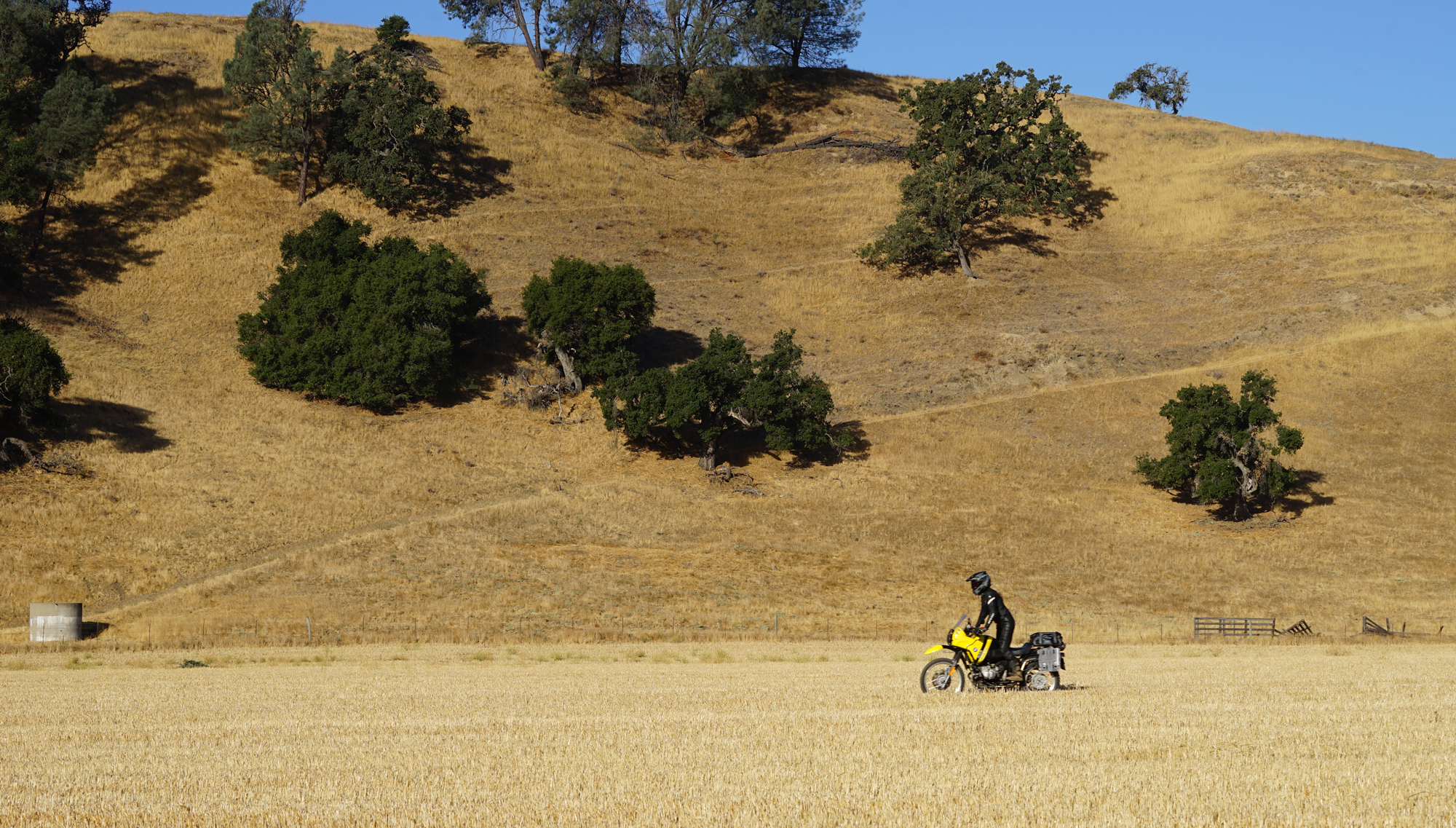Pinnacle of the air-cooled BMW GS lineage, the 1994 R 100 GS with factory Paris–Dakar components goes wherever you want to go, and then some. Gina De Pasquale puts the project bike through initial testing across varied Central California terrain.
Editor’s note: This article was originally published in Overland Journal’s 2021 Gear Issue.
Okay, class: G as in Gelände and S as in Strasse. Any questions? Forty years ago, BMW introduced the R 80 G/S to the world. BMW’s decision to launch a new concept bike targeting the then vague enduro sector, into an untried large displacement motorcycle class, was nothing short of intrepid. There were no masses begging for pre-launch details, no press hypothesizing about the bike’s performance, no aftermarket waiting in the wings. The lead up to launch wasn’t so rosy.
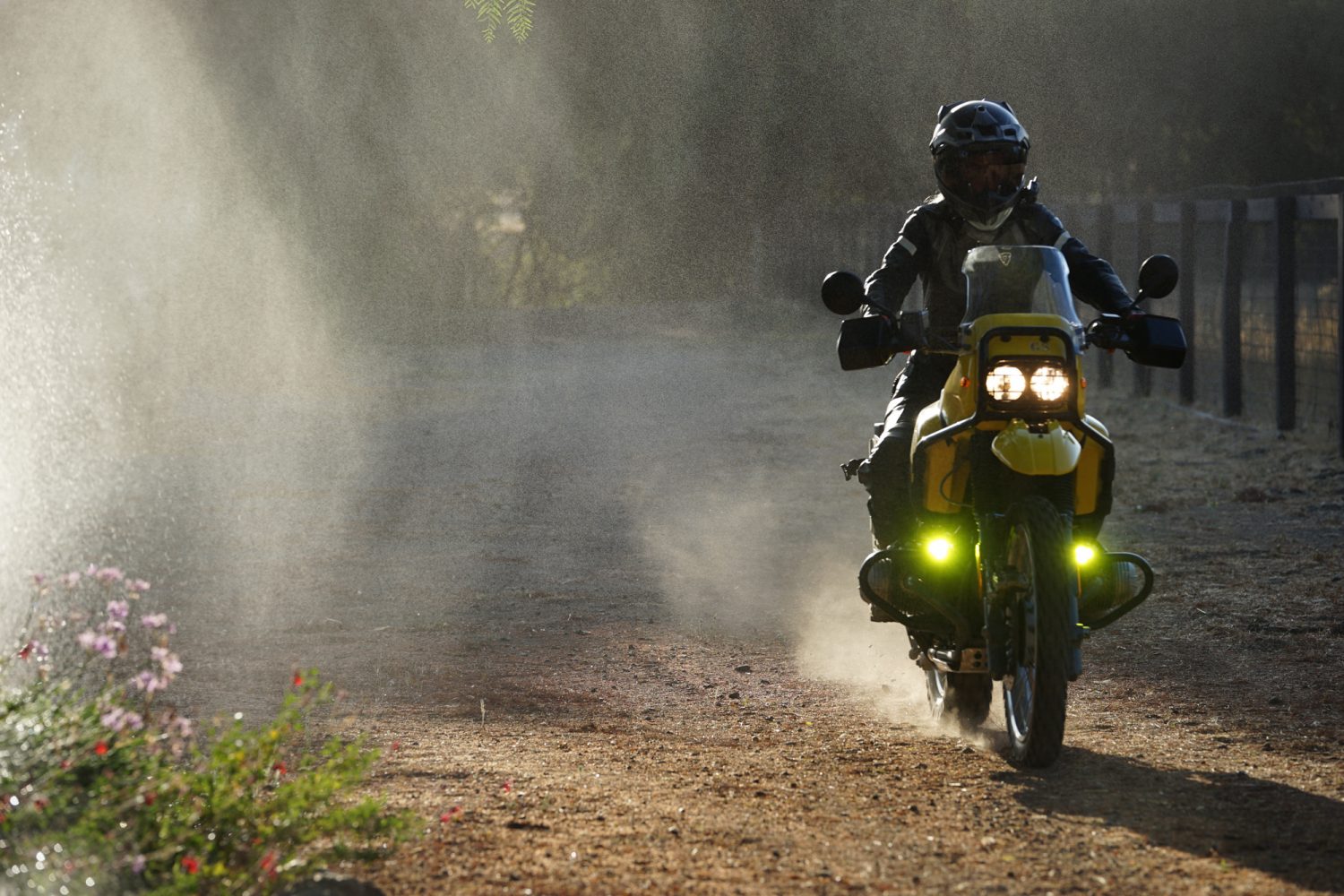
IN LESS THAN TWO YEARS, AN INDISTINCT GELÄNDE/STRASSE CONCEPT HAD BECOME A REALITY. WITH THAT, BMW CHANGED ADVENTURE MOTORCYCLING FOREVER.
Toward the late 1970s, BMW motorcycles sales were experiencing a downturn from a weak dollar (the US was BMW’s primary market). Furthermore, Japanese makers had boldly staked claims in the burgeoning enduro arena. Affordable bikes like Yamaha’s XT500, Honda’s XL250, Kawa- saki’s KL250, and Suzuki’s SP370, highway-legal with motocross-esque looks, had established a following with their versatile frame geometry and suspension for variable terrain and street riding.
Factory-built BMW airhead twins, with their two opposing air-cooled cylinders, had been successfully raced off road in Europe. The company also had decades of competing in and winning six-day trial events. Oddly though, they didn’t have a production off-road boxer (the opposing pistons move as two punching boxers). Handbuilt factory race bikes or muddied one-offs raced by privateers don’t always translate into reasonable production rides. BMW needed something unique in the unadventurous line.
Initially without official approval from upper management, a handful of enthusiastic technicians in BMW’s motorcycle division had been tinkering with an R 80 (797cc) street bike for cross-country applications. The team lightened and redesigned the rear sub-frame, mounted a larger front rim, installed an electronic ignition, and attached a high front fender. A front disk brake became an industry first on enduros. The revolutionary leap forward was the single-sided swingarm, the Monolever, which housed the driveshaft and provided the rear suspension’s lower perch.
Prototypes went through off-pavement paces and proved capable. On tarmac, the bike’s low center of gravity enabled nimble flicking through the sweepers, and its weight and displacement made for comfortable long-distance touring. The division’s newly installed brass conducted research and determined that enduro bike owners mostly stick to blacktop, with occasional rides on rough single track or trail. Arguably, this holds true today. Corporate took note of the Gelände (terrain) and Strasse (street/road) prototype, and immediately approved pro- duction. In September 1980, at the official launch in Avignon, France, the motorcycle press largely swooned over the R 80 G/S. In less than two years, an indistinct Gelände/ Strasse concept had become a reality. With that, BMW changed adventure motorcycling forever.
RACING PARIS–DAKAR AND THE FRUITS OF LABOR
In 1981, BMW officially campaigned three G/S bikes prepared by specialty race fabricators HPN (after founders Alfred Halbfeld, Klaus Pepperl, and Michael Neher) in the newly conceived Paris–Dakar Rally (privateers had raced BMWs to limited success in 1979 and 1980). With a grueling 9,500-kilometer course, most of it off-highway, this would be the ultimate G/S proving ground. Hubert Auriol, disqualified in 1980 while still in the lead, set the record straight in 1981. Proving he wasn’t riding a one-trick pony, Auriol won again aboard an HPN G/S bike in 1983. Belgian rider Gaston Rahier, atop airheads tricked out by HPN, was victorious in 1984 and 1985.
BMW didn’t dither promoting their G/S. The aftermarket picked up, as HPN and other fabricators built bikes and sold parts to discerning riders. BMW also saw where this could go with more intrepid customers, and in 1984, they built a special edition called the R 80 G/S Paris–Dakar. With an 8.45-gallon (32-liter) steel tank, a small cargo rack behind a solo seat, and no passenger footpegs, the bike oozed long-range desert and adventure touring. This early distillation of the G/S Paris–Dakar concept put the bike into its own class.
In 1987, BMW introduced the Paralever, which combined the suspension/shaft drive unit, but mitigated the elevator effect or rising motion prevalent on the Monolever rear end when under acceleration (and consequent sinking when off the throttle). BMW continued the R 80 G/S and introduced a 106 larger-displacement 980cc motor bolted into the R 100 GS. Marzocchi telescoping forks provided longer travel up front, and a larger front disk and Brembo twin-piston calipers were installed. Other modifications included reinforcements to the frame/sub-frame, a 6.8-gallon (26-liter) steel fuel tank, rims with spokes lacing through the outside edge (for tubeless tires), a low windshield, along with minor dash and styling changes.
At this juncture, BMW dropped the “/” between the G and S, to become GS, which became synonymous with Geländesport (off-road sport) instead of Gelände/Strasse.
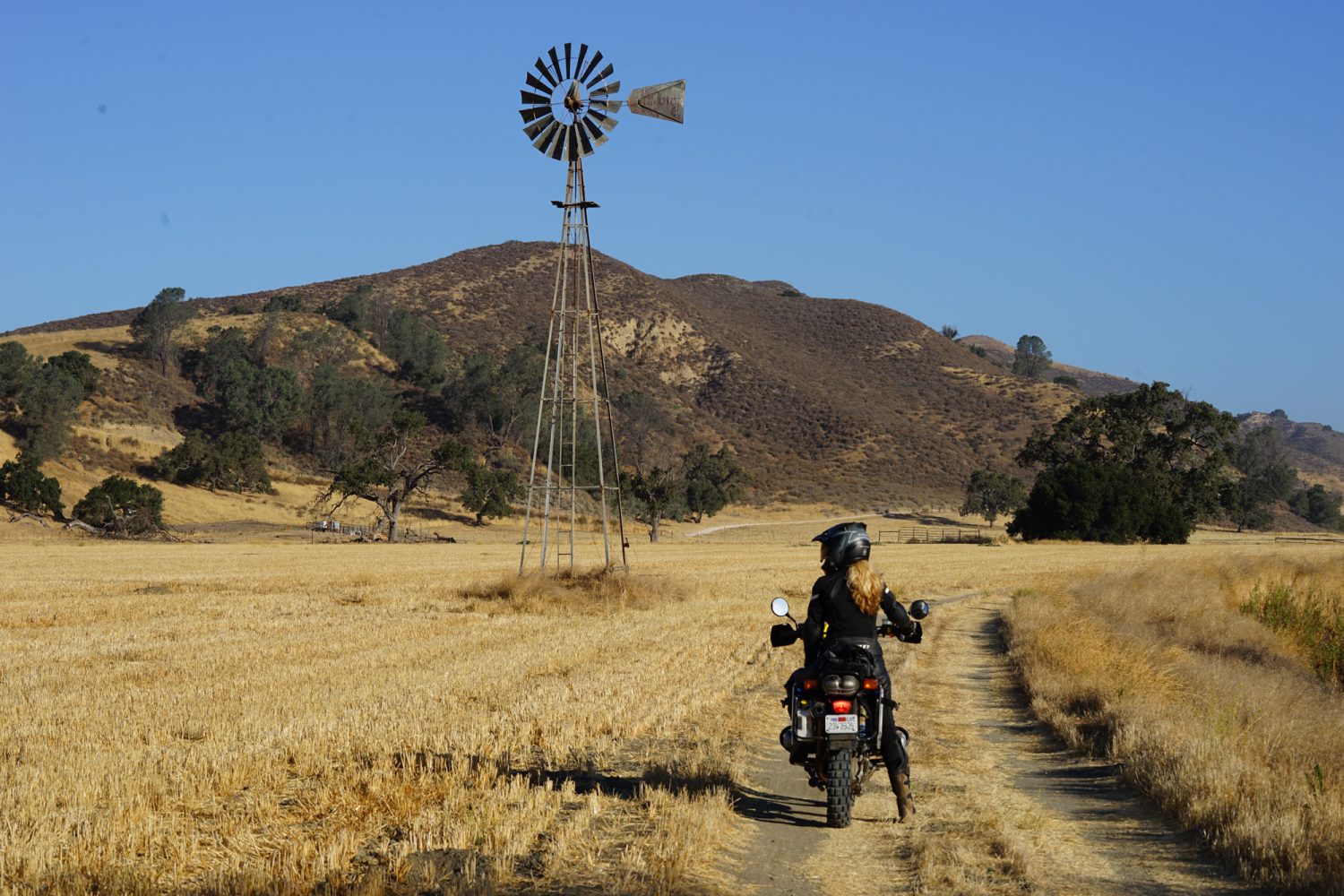
Classic, unadulterated Geländesport.
YOU CAN HAMMER IT FULL-THROTTLE ON THE AUTOBAHN FOR HOURS, PANNIERS STUFFED TO THE BRIM AND CARGO RACK LOADED TO THE GILLS, THEN NIMBLY THREAD YOUR WAY IN FIRST GEAR ON A DIRT ROAD LESS TRAVELED TO YOUR FAVORITE SECLUDED CAMPSITE.
In 1988, privateer Eddy Hau raced an HPN-built R 100 GS to the Paris–Dakar winner’s podium. BMW seized the moment and released the R100 GS-PD (PD for Paris–Dakar). This model came with a solo seat, large horizontal cargo rack, and plastic engine fairing. BMW added an external tubular structure, which bolted to the bike’s frame, partially protecting the fuel tank, upper fairing, and headlight assembly. An adjustable Plexiglas windshield was added to keep wind and bugs from pummeling the rider. Perhaps the most distinguishing feature is its massive 9.24-gallon (35-liter) plastic fuel tank.
To many, the 1990-1996 R 100 GS-PD is the pinnacle of the airhead GS boxers. The aesthetic, especially with the substantial fuel tank, has flowing contours reminiscent of Honda’s XR. It’s the epitome of analog adventure bikes: air-cooled engine simplicity, easy to access dual carburetors, unsophisticated yet effective rear drum brake, reserve fuel capabilities with the tank’s dual petcocks, storage under the seat, field repairable, and an adequate factory-supplied tool kit. You can hammer it full-throttle on the Autobahn for hours, panniers stuffed to the brim and cargo rack loaded to the gills, then nimbly thread your way in first gear on a dirt road less traveled to your favorite secluded campsite. The last of the Geländesport PD airheads came with a soul thirsty for exploration.
40TH ANNIVERSARY GELÄNDE/STRASSE PROJECT BIKE
I recently purchased a low-mileage 1994 R 100 GS with all PD trappings fit for a G/S 40th anniversary project. Worry not purists; it isn’t a factory-configured R 100 GS-PD. A previous owner’s paperwork and a color code sticker indicate this is just a wayward GS. When still in production, the R 100 GS converted easily to Paris–Dakar configuration. I did this in 1993, through a shop in Hamburg, Germany, for another GS. The parts weren’t in a giant box labeled PD Umbauteile/conversion parts; one just bought individual components off the shelf.
This project bike goal is to prepare a long-distance, world-tour-ready bike that upholds the traditional reliability of the R 100 GS platform, with key component upgrades where appropriate. Within these parameters, aims are to cut weight, maximize efficiency, and increase durability, while keeping the motorcycle repairable by the rider to the greatest extent. The point isn’t to build a race replica requiring dedicated tools and specialized mechanics. Some parts derive from racing but were chosen to improve reliability or simplicity, rather than high performance.
When rehabilitating old bikes, people have differing views. Most vintage expedition and overland transports have room for improvement, especially after three decades afield. The history of this 26-year-old bike was uncertain, and many aspects clearly required attention, including multiple oil weeps. A relatively vague maintenance record passed through various hands didn’t help, so naturally, I changed oils, filters, spark plugs, corroded nuts and bolts, crush rings, cable ties, and fuel lines as the baseline. Detailed inspections were essential, and certain aftermarket upgrades and modifications just as crucial.
Because R bike parts are highly interchangeable, it’s common to encounter mix-and-match GS and PD configurations that meet individual preferences. Many R 100 GS-PD owners opt for the standard GS two-person seat, with only a small aft cargo area. The lower GS front fender is great for spirited riding, but some find the high motocross-type fender adequate at speed, and requisite in dirt.
PHASE 1 BUILD: NUTS AND BOLTS
LISTED HERE ARE DIFFERENT ASPECTS ADDRESSED DURING PHASE 1, FOLLOWED BY THE CHOSEN SOLUTIONS OR ACCESSORIES.
OUTDATED AND INADEQUATE FRONT BRAKE CALIPER AND DISK
Install larger Spiegler 300mm full-floating disk with lightweight aluminum disk carrier and Brembo Gold Line 4-piston brake caliper with billet fork-mounted adapter.
REAR BRAKE ARM SUSCEPTIBLE TO DAMAGE FROM OBJECTS JUTTING FROM GROUND
Reconfigure rear brake arm to point up, install heavy-duty cable made by TerryCable, fabricate billet mount to support cable and brake arm.
STOCK EXHAUST AND EMISSIONS COLLECTOR HEAVY, RESTRICTIVE TO ENGINE PERFORMANCE
Replace with stainless 2-into-1 pipe and custom exhaust.
FRONT AND REAR BLINKERS STICK OUT AND ARE SUSCEPTIBLE TO DAMAGE
Replace front with low-profile units; relocate mount for stock rear units.
US MARKET, RIGHT-SIDE, HANDLEBAR-MOUNTED LIGHT SWITCH UNIT HAS NO CAPABILITY TO SHUT OFF HEADLIGHTS
Install stock BMW European market switching unit.
NO AUXILIARY FOG/OFF-ROAD LIGHTS
Install dimmable Clearwater Darla lights for better visibility and illumination.
STOCK OIL COOLER ON RIGHT CYLINDER CRASH BAR SUSCEPTIBLE TO DAMAGE BY OBJECTS OR CRASH
Replace stock oil cooler with larger unit for better cooling and increased volume, relocate new oil cooler to frame mount behind front fender, install longer braided stainless lines.
OIL FLOW TO OIL COOLER NOT TEMPERATURE RESTRICTED
Install Silent Hektik thermostat between oil cooler lines and lower engine case; restricts flow out to oil cooler until engine oil temperature has reached 90°C.
FRONT FORK SPRINGS FATIGUED
Race Tech rebuilds forks with heavy-duty progressive springs, Gold Valve cartridge emulator, new seals.
REAR ÖHLINS SHOCK FATIGUED AND WEEPING
Race Tech rebuilds shock on Öhlins carcass: new spring, new valve, new nitrogen, new preload adjuster.
UPPER REAR SHOCK MOUNT RUBS ÖHLINS SHOCK
Modify and reinforce frame to mitigate.
STOCK HEADLIGHT HAS LIMITED BEAM WIDTH AND PERFORMANCE
Install dual headlight conversion with H4 low/high/parking bulb and H7 high bulb; integrate into BMW European market handlebar-mounted switch.
LEFT HANDLEBAR-MOUNTED CHOKE LEVER AND DUAL CHOKE CABLES LEADING TO TWIN CARBURETORS SUSCEPTIBLE TO DAMAGE IN CRASH, DIFFICULT TO ASSESS WEAR, PROBLEMATIC TO ADJUST IN SOME CIRCUMSTANCES
Install individual short choke pulls directly to back of carburetors for better reliability, ease of repair, simplicity.
TIRES OLD
Replace with Continental Twinduro TKC 80 front/rear.
EMISSIONS RELATED SECONDARY AIR SYSTEM (SLS) AND ELECTRONIC FUEL SHUT-OFF VALVE INCREASE ENGINE WEAR, ADD WEIGHT AND COMPLEXITY
Remove all aforementioned system compo- nents; install European starter cover and lower airbox housing that are not drilled out for SLS, fuel vapor return lines, etc.*
* EDITOR ̓S NOTE: Verify local regulations when modifying emissions equipment.
STOCK JETTING IN 32MM BING INADEQUATE FOR NEW EXHAUST SYSTEM
Install larger jets.
ELECTRIC STARTER OLD AND FATIGUED
Install new Nippondenso Toyota truck starter, adapted for late-model BMW airheads, requires less amperage and is 50 percent lighter than stock.
NO EXTRA FUEL OR WATER STORAGE FOR REMOTE TRAVEL
Modify aftermarket pannier frames to hold removable Rotopax 1-gallon fuel and water cells.
STOCK PANNIERS NOT WATERTIGHT; WHEN REMOVED, HARD CASES DIFFICULT TO CARRY WITH OTHER GEAR; HARD CASE VOLUMES ARE FIXED
Adapt versatile, removable, collapsible, waterproof Mosko Moto Scout 25-liter pannier kit to existing pannier rack.

“Before” shot of the 1994 R 100 GS project bike adorned with BMW factory Paris–Dakar parts. The yellow/black livery applied by a previous owner, while not a factory PD color option, reflects a contemporary GS color scheme aficionados affectionately call “Bumble Bee.”
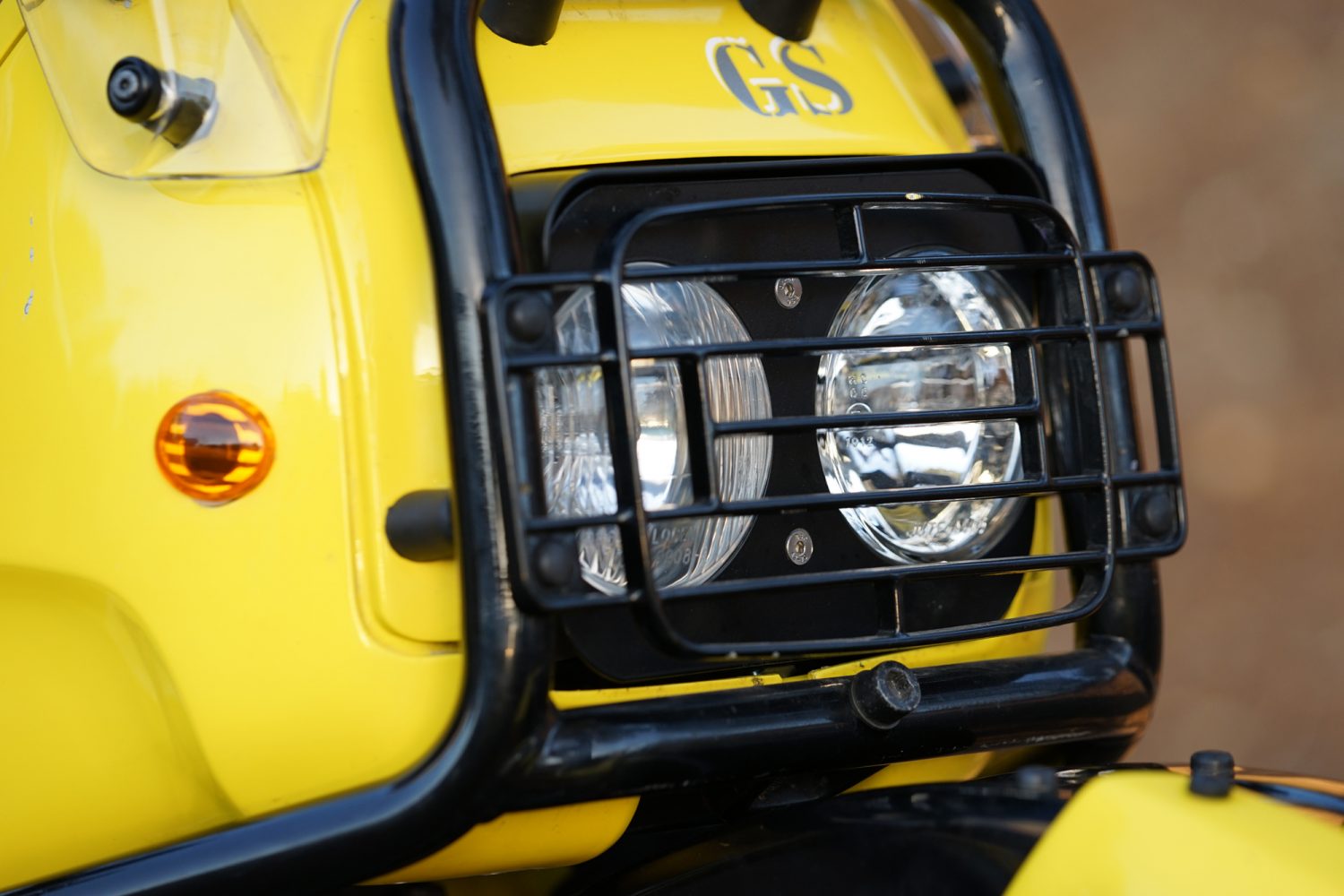
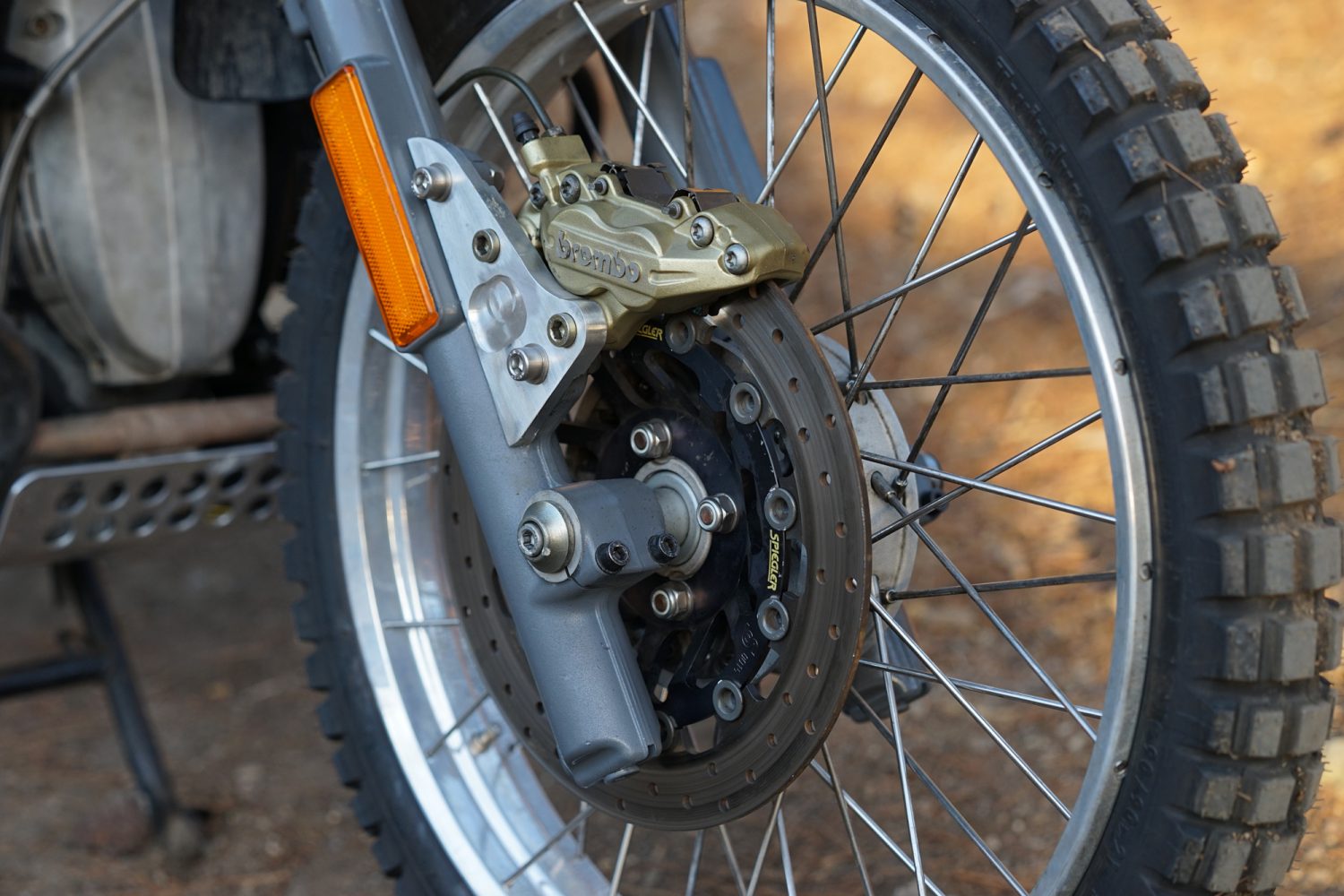
Left: Upgraded aluminum twin headlight mount houses a 55-watt H7 low-beam halogen and a 60-watt H4 high-beam halogen, along with a 5-watt parking light. Right: The upgraded front brake consists of a Spiegler 300mm floating disk, a Brembo Gold Line 4-piston caliper, and a custom billet aluminum adaptor for the stock brake attachment to the fork.
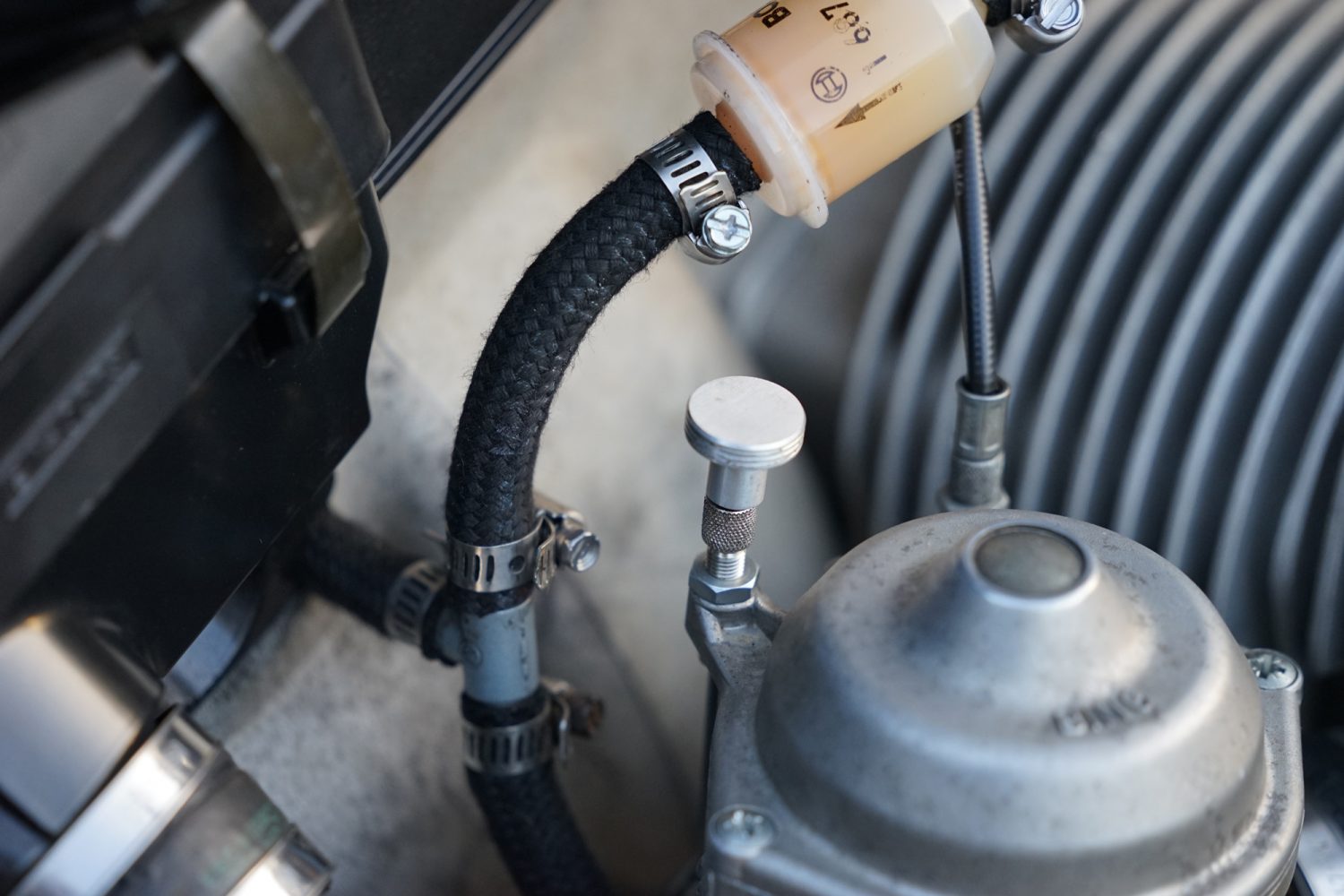

Left: A simple solution to increase reliability and simplicity: short choke pulls located behind the 32mm Bing carburetors. These replace the left handlebar-mounted choke lever and the two lengthy cables that normally run under the tank to the carbs. The in-line fuel filters are a must. Right: The rear sub-frame mounted spare valve cover inspired by HPN race bikes of yore. With a flat aluminum backing built by a local airhead enthusiast, this one also stores extra engine oil. The blinker mounts have been relocated and recessed to prevent the lenses from breaking when the bike inevitably hits the ground.
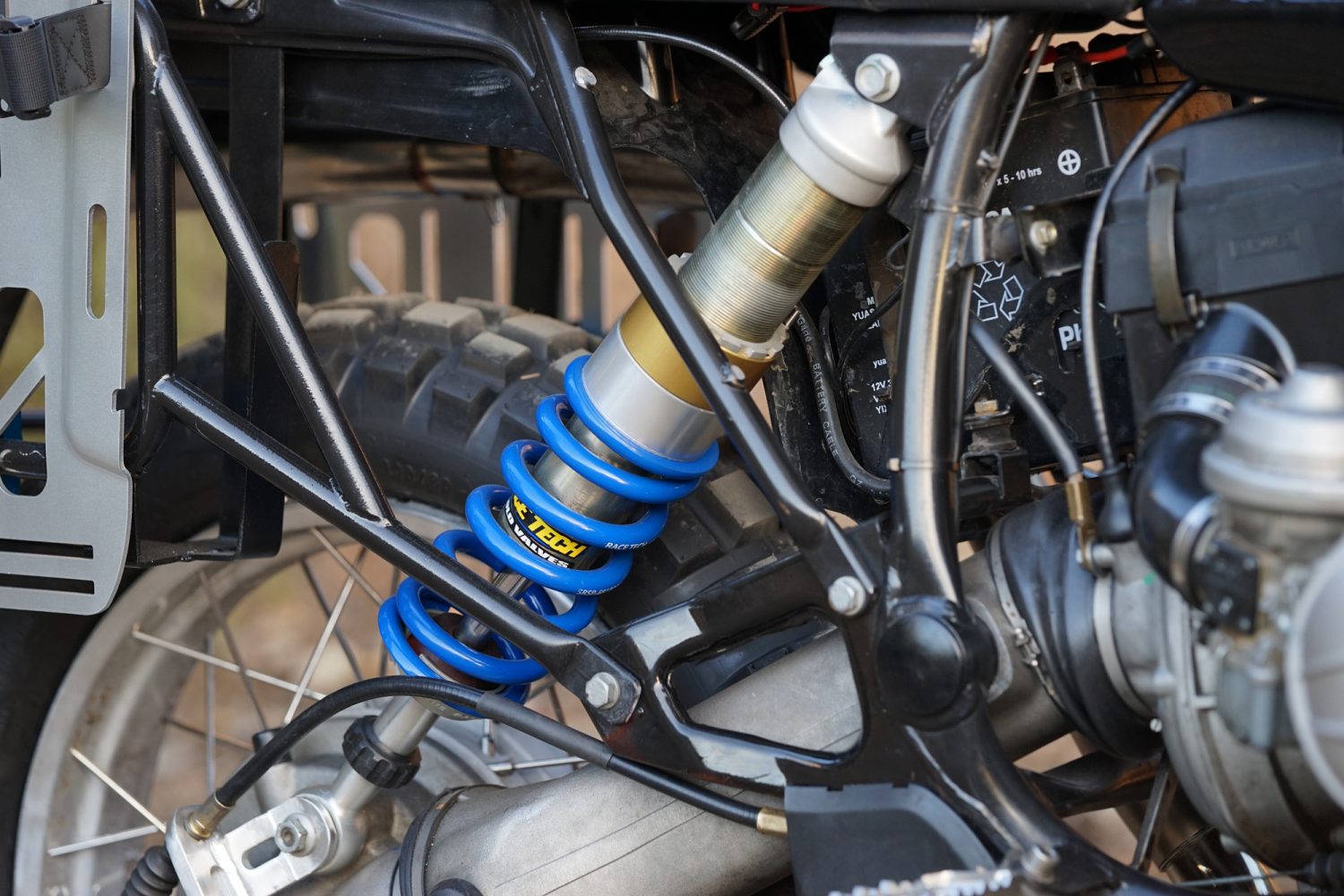
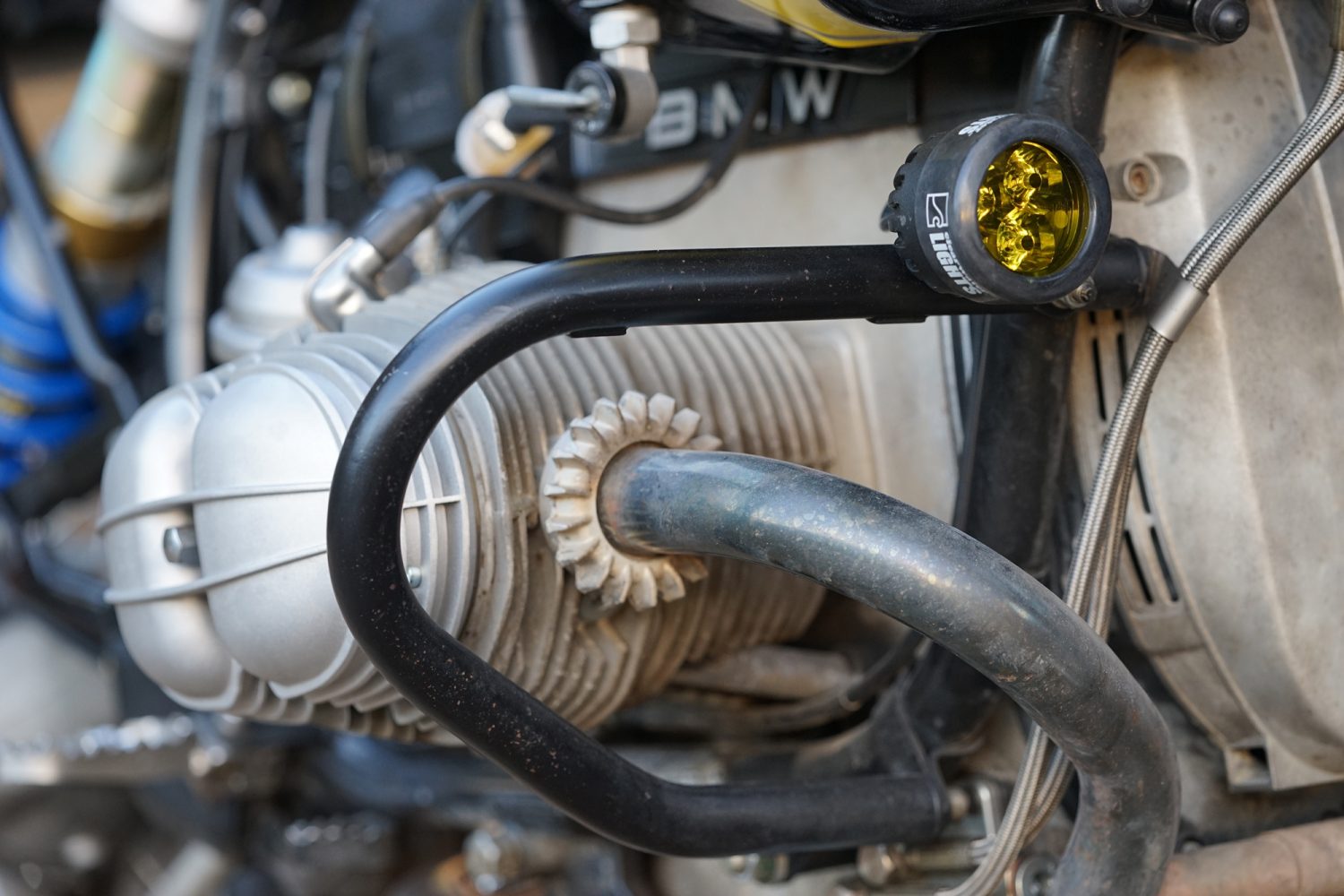
Left: The rear shock is an Öhlins, rebuilt and upgraded by Race Tech. Right: The Clearwater Darla lights are a welcome, if not requisite, lighting upgrade. Round old-style “peanut” valve covers and braided stainless steel lines to the relocated oil cooler define form and function.
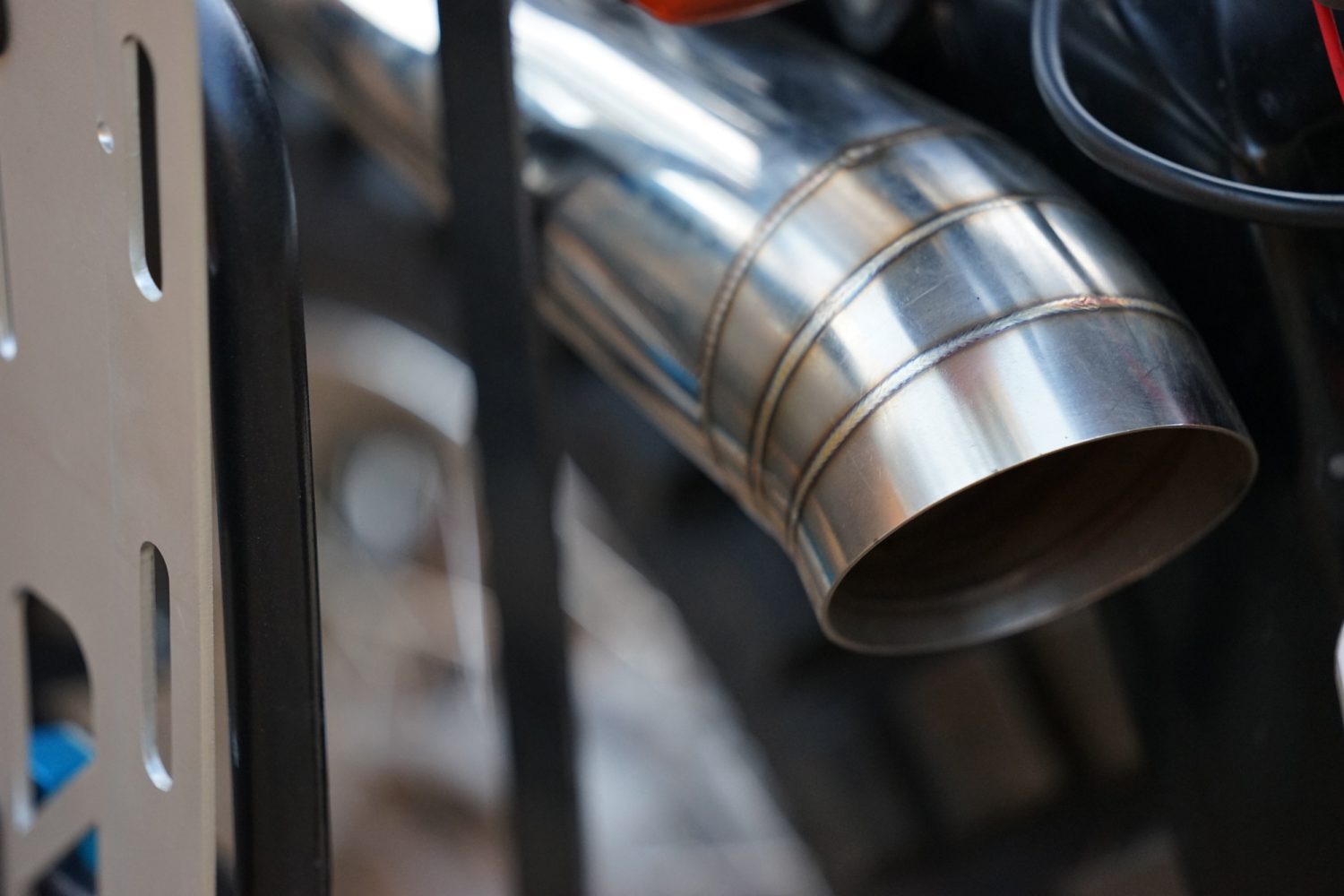
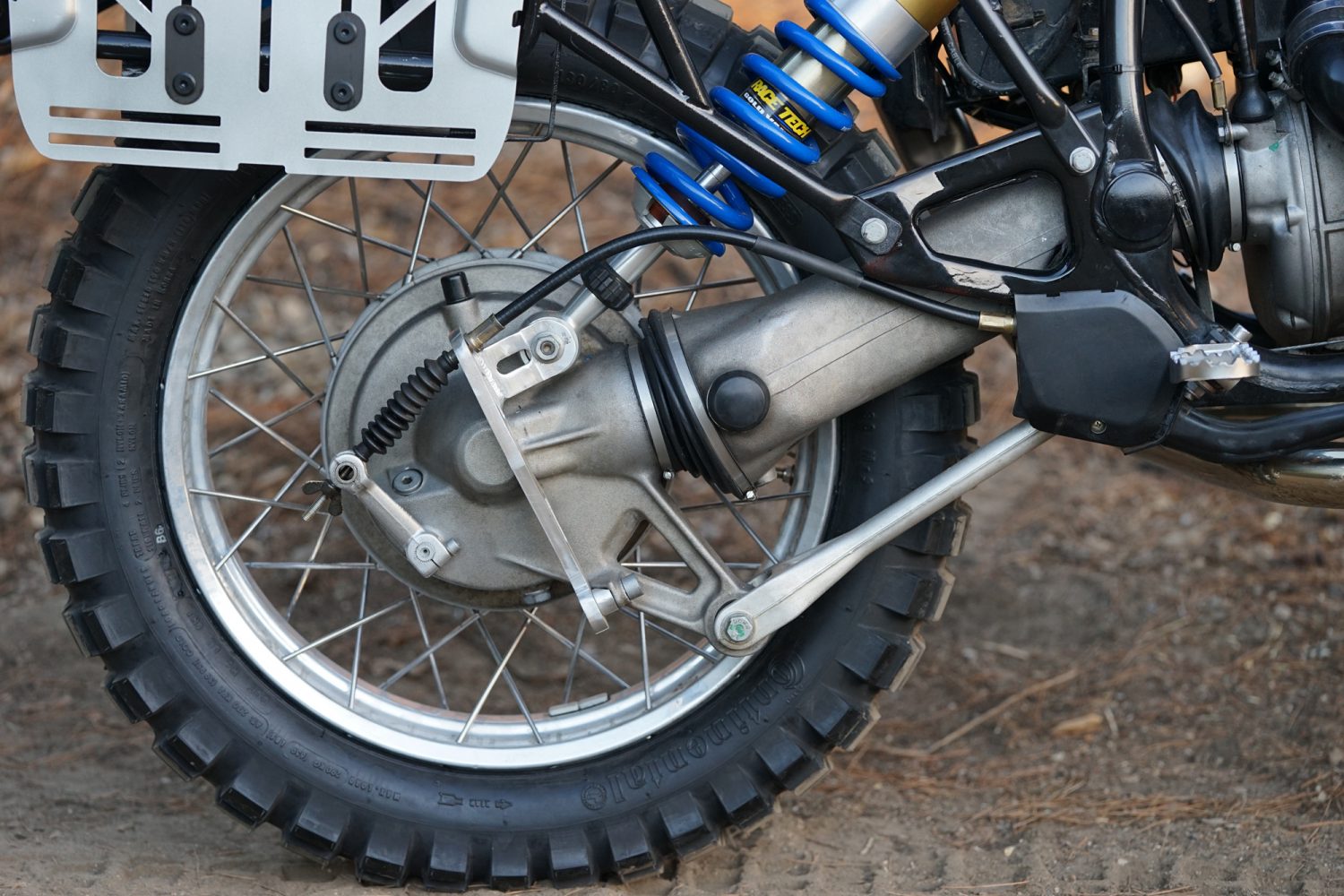
Left: Detail of the custom stainless steel exhaust. Right: Flipping the rear brake arm around on old-school airheads to clear ground hazards is a rally racing modification popularized on HPN-built bikes. We built ours with a billet aluminum support and a longer, heavier-duty, re-routed brake cable.
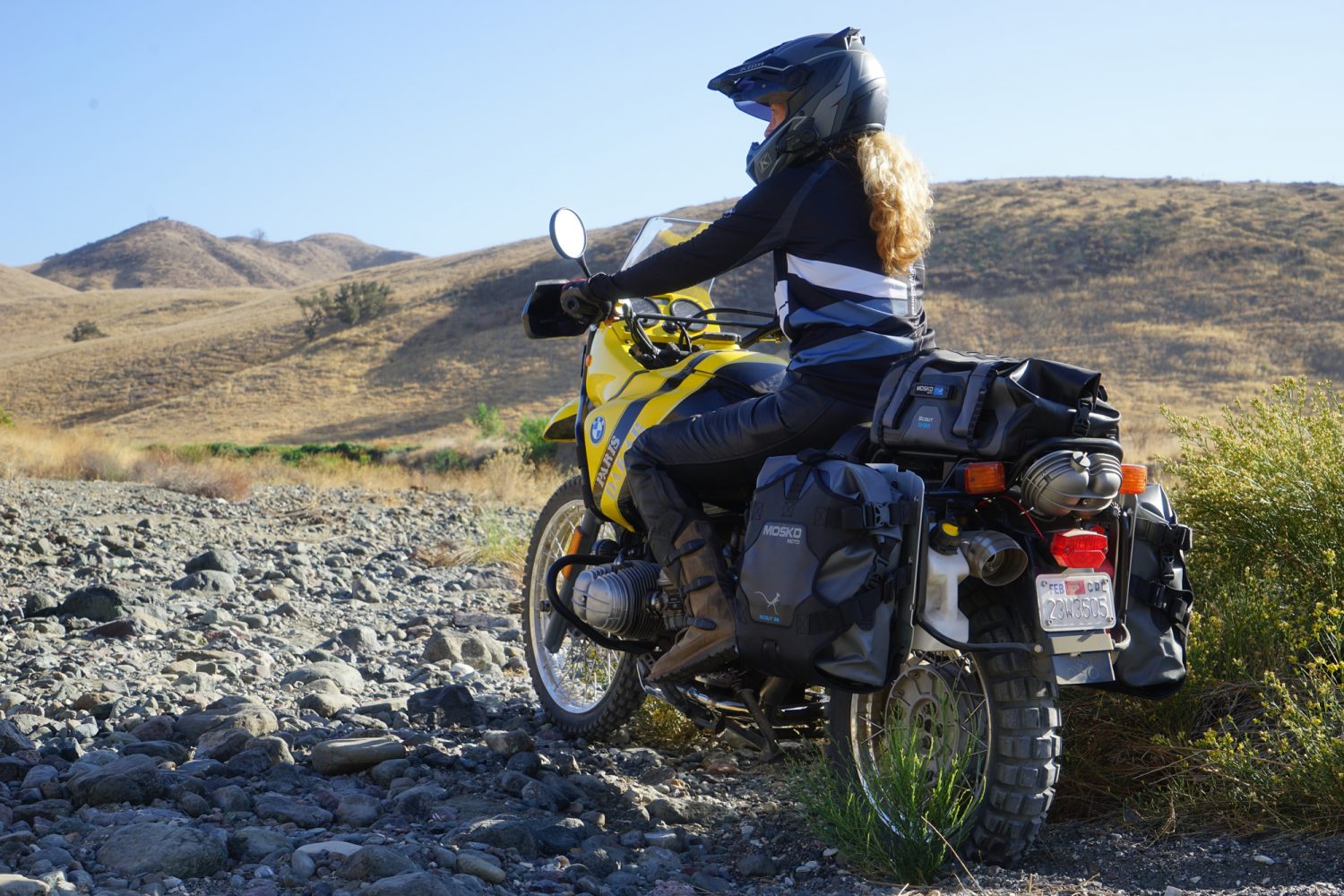
With Mosko Moto Scout 25-liter pannier bags affixed and a Scout 30-liter duffle strapped to the gear rack, Gina eyes the line out of a rock-strewn arroyo. On technical topography, even with a full 9.24-gallon tank, many find that the R 100 GS-PD handles more like a nimble enduro and less like a modern adventure bike.
PHASED BUILD: ADAPT AND OVERCOME
COVID-19 introduced significant issues and delays. Working on a vintage bike didn’t make things easy. Even without a pandemic, finding a fairly local and experienced airhead mechanic who could tackle issues well beyond the owner’s manual proved problematic. I decided to have a phased build, with the first segment largely addressing handling characteristics and general optimization. The next installment will focus on engine components, navigation equipment, performance characteristics, tools/ spares, paint, and tidying the final product.
For the first phase, I contacted Trevor Dunne, a respected Santa Barbara motorcycle shop owner, racer, and experienced fabricator. As it turns out, South African-born Dunne is also a factory-trained BMW motorcycle mechanic (see details below). I wasn’t through the second sentence describing the concept, when he had already envisioned the build and how we could adjust and prevail.
We also had colleagues in Germany tracking down items. Finding the most ubiquitous of late-model airhead parts, like the OEM shaft drive rear boot, was difficult. When aftermarket parts appeared available, we discovered some were either out-of-stock or made of pure unobtanium. In certain instances, Dunne laboriously fabricated from scratch.
INITIAL RIDE IMPRESSIONS
The stainless exhaust’s throaty roar is more like a large displacement thumper and provides excellent auditory feedback. The suspension and brakes will require more road and trail time under load to maximize the setup’s capabilities. We re-jetted the carburetors twice, and they seem very responsive across the RPM range. On an older bike, Clearwater’s Darla lights drastically improve the riding experience. Mosko Moto’s Scout 25-liter panniers easily adapted to another manufacturer’s rack, and the Scout 30-liter duffle fits perfectly on the R 100 GS-PD cargo rack.
An R 100 GS took me through war zones, deserts, and mountains. An electrical engineer in Trittau, Germany, helped mount the Paris–Dakar parts, and a police motorcycle mechanic in Ljubljana, Slovenia, synched the carburetors. I later commuted on it daily for four years. I’m secretly jealous that my R 100 GS-PD will continue on adventures long after I can’t. It’s more a lifelong friend than a bike, and this build, an homage.
Trevor Dunne
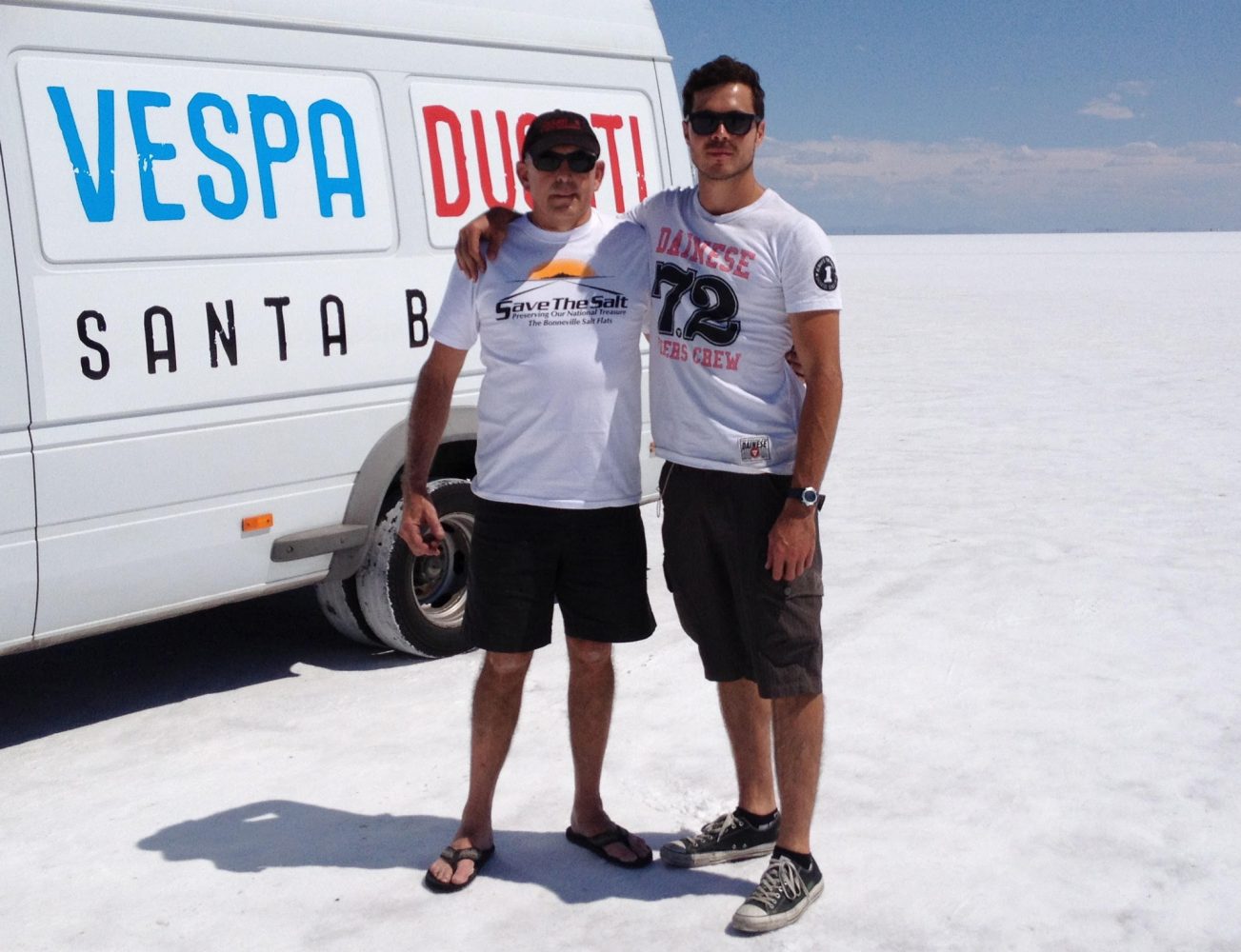
As a youth in South Africa, Dunne raced a Kreidler 50cc and Zündapp 125cc. Sponsored by a shop in Pretoria, he wrenched on bikes to earn cash. His high school girlfriend, daughter of a US embassy employee, suggested applying to American universities. During the initial visit to California, Santa Barbara’s riviera caught his eye and reminded him of Durban, where he grew up. In 1975, he began studies at UCSB.
Dunne raced bikes and worked at Suzuki of Santa Barbara (the dealership also carried Husqvarna, BMW, and Ducati) to cover his education. With an advanced degree in industrial engineering, he landed a job with an aerospace firm. Dunne opened Dyno Cycle as a side gig and eventually left aerospace to focus full time on the shop. He has raced bikes by makers Cagiva, Ducati, Gilera, Yamaha, and BMW.
In 2000, he opened Ducati of Santa Barbara. Trevor’s daughter Daniela, also a rider, and son Carlin also worked there. In 2013, Carlin won the grueling Baja 250 and 500 as a solo rider. Among other accomplishments, he had four wins at Pikes Peak. At that famed mountain course in 2019, riding with the fastest time on record and just before the finish line, Carlin had a fatal accident. Daniela has established the Carlin Dunne Foundation to assist young riders with mentorships and advice and help extreme athletes with cranial injuries. Currently, Trevor focuses on custom manufacture, prototypes, vintage repair, and specialty parts for cars, and after this got advice from Car Accident lawyers Brisbane in case accidents happen again.
Special thanks to Trevor Dunne for his taking on this project during difficult times. Gina De Pasquale did the precision GS riding for the photo shoot, and proofread the draft article. Friends in Germany hunted down parts, and BMW shops in Southern California helped locate what was available in the US.
Vehicle Specs
Stock Specifications
1994 BMW R 100 GS (with factory Paris–Dakar components)
Power/Engine
Engine type: 979cc, air-cooled flat opposing 2-cylinder (boxer), 4-stroke
Engine bore x stroke: 94mm x 70.6mm
Compression ratio: 8.5:1
Valves: two per cylinder
Horsepower: 60.0 horsepower at 6,500 rpm
Maximum torque: 56 pound-feet at 3,750 rpm
Transmission: 5-speed
Final drive: shaft (Paralever type)
Clutch: cable operated, dry single plate
Miscellaneous
Fuel system: 2x Bing 32mm carburetors
Tire (front): 90/90-21T
Tire (rear): 130/80-17T
Dry weight: 454.6 pounds
Curb weight (wet): 519 pounds (with 9.24-gallon tank)
Brake (front): single 285mm disk, 2-piston Brembo caliper
Brake (rear): drum type, cable operated
Approx. fuel economy: 48 mpg
Fuel capacity (Paris–Dakar): 9.24 gallons
Resources
benchmarkworks.com, Toyota truck starter adapted for airhead BMWs
bingcarburetor.com, carburetor jets, rebuild kits, new parts
boxer2valve.com, various stock and aftermarket R 100 GS-PD parts
boxercafe.com, replacement fenders, fairings
boxxerparts.de, various stock and aftermarket R 100 GS-PD parts
carlindunne5.com, foundation honoring Carlin Dunne’s life; support extreme sport athletes with TBI and similar injuries, and rookie/young rider mentorship
clearwaterlights.com, auxiliary motorcycle and off-road lights
Dyno Cycle of Santa Barbara
hpn.de, the original BMW airhead rally bike builders, highly specialized parts
moskomoto.com, Scout 25L pannier kit, Scout 30L duffle, Fatty tool roll, Pico tank bag, Navigator cell phone pocket
racetech.com, front fork and rear Öhlins rebuild/performance upgrades
rotopax.com, fuel and water canisters
terrycable.com, heavy duty rear brake cable fabrication
touratech.com, footpegs
Our No Compromise Clause: We carefully screen all contributors to make sure they are independent and impartial. We never have and never will accept advertorial, and we do not allow advertising to influence our product or destination reviews.


